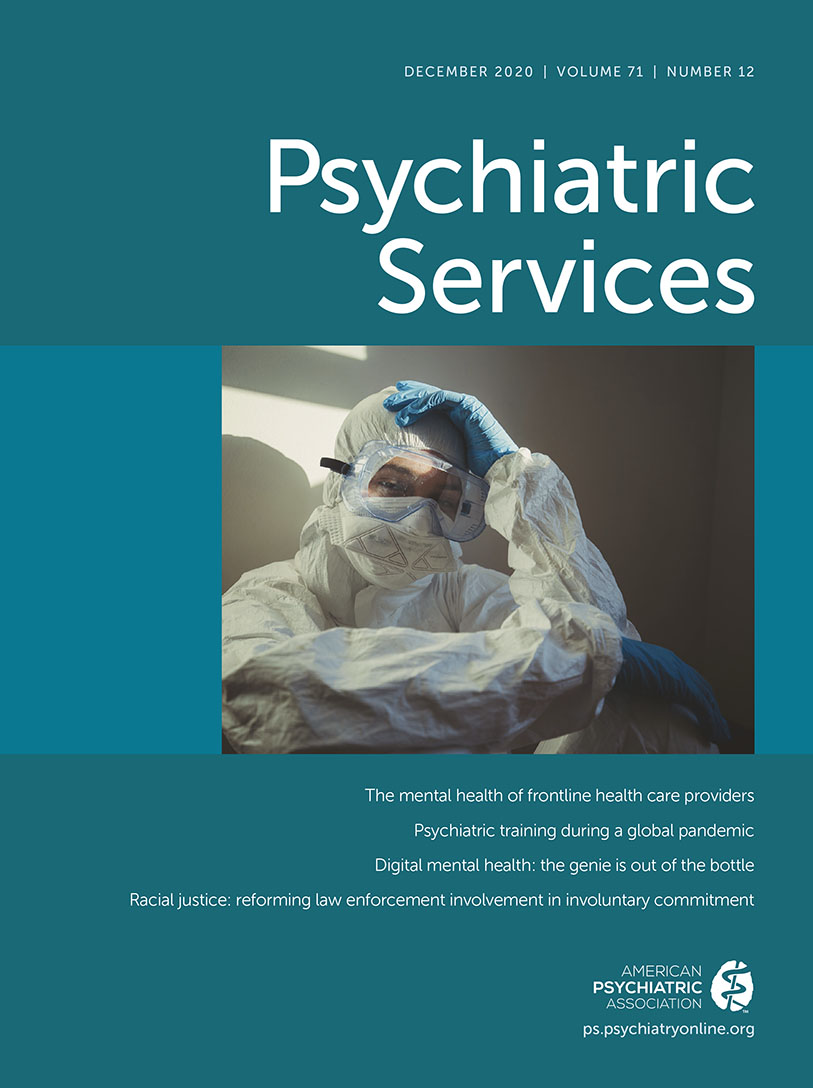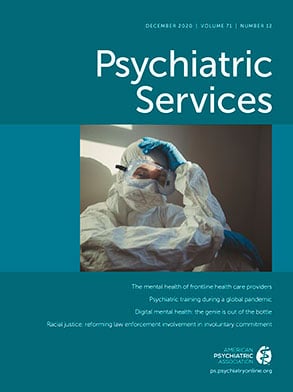The COVID-19 pandemic has led to unprecedented use of technology in mental health care. Comprehensive mandates to adopt social distancing measures have been implemented globally, blocking the ability of clinicians to deliver in-person care. Disruption of standard services coupled with a spike in the mental health needs of a population experiencing social isolation, economic upheaval, anxiety, and psychological trauma, have created an untenable crisis. Necessity compelled us to take bold steps, and it was heartening to see health care systems, regulatory agencies, and policy makers mobilize to embrace technological methods to deliver much needed mental health services. Salient examples include widespread implementation of two-way video as the primary alternative tool to conduct tele–mental health sessions in hospital, community, and private mental health practice settings with the government’s waiving of Health Insurance Portability and Accountability Act (HIPAA) penalties to providers who use everyday communication software (
1); a surge in the use of clinical messaging services that enable asynchronous texting interactions between patients and remote clinicians (
2); deployment of digital mental health applications and loosening of the regulatory restrictions governing their use (
3); and mass dissemination of mental health and well-being resources through social media, online streaming services, and other widely accessible platforms. In a few short yet intensive weeks, the coronavirus crisis and the collective rapid response to emergent patient needs have proven to be the greatest singular catalyst for adoption of digital mental health technologies seen to date.
It is unlikely that we will see a full return to traditional in-person mental health service models when the COVID-19 pandemic subsides. Evolving patient preferences, provider attitudes and capacities, and new digital mental health research will facilitate ongoing integration of technology at all levels of care. Patients who transitioned to treatment via digital platforms are now learning, perhaps for the first time, that such options exist. Many of them will have powerful firsthand experiences—whether it is realizing that they can maintain a positive therapeutic relationship with their clinicians remotely or whether it is becoming more cognizant of how much of their time, effort, and resources have been previously spent getting to and from the clinic. Moreover, there will also be a segment of new mental health service users who sought treatment only after the COVID-19 pandemic took hold. For them, stepping away from the only treatment modalities they have ever come to experience would not constitute a return to “normal.” Whether they are new or veteran treatment seekers, we can expect many patients and their family members to advocate for a continuation of technology-supported services.
Clinicians who are trying telepsychiatry for the first time may find that, surprisingly, they are still able to provide high-quality care. Many self-proclaimed “traditionalists” and “technophobes” who were hesitant to experiment with new technological platforms prior to the pandemic are learning that with some trial and error, they too are capable of mastering the use of digital health technologies. Their perceptions of what their patients are willing and able to do may also shift as they see an accumulation of positive treatment outcomes, better treatment engagement, and fewer last-minute session cancellations. These experiences may be particularly surprising for clinicians who treat people with serious mental illness—individuals who are often erroneously perceived by their providers as less capable, savvy, or open to using technology than the evidence suggests (
4). Health care administrators are already learning that patient referrals and caseloads can be maintained or even expanded with the efficiencies afforded by technology, especially if evolving policies continue to allow the use of the same billing and reimbursement codes for remote delivery of technology-supported interventions. Health information technology professionals and administrators at hospitals and clinics are realizing that a combination of external demand, internal directives, and appropriate resource allocation serves as a strong motivator for integration of video streaming, chat, and mobile data collection capacities into their electronic health record systems. As a digital health researcher who has multiple collaborations with providers throughout the country, it has been remarkable for me to witness how quickly interoperability issues, patient privacy and data security concerns, and other challenges deemed “intractable” before the pandemic were resolved successfully in response to the political pressure that emerged shortly afterward.
Clinical researchers, treatment developers, and technologists are learning that there are enormous unmet needs and opportunities for leveraging their talents in digital mental research. Researchers who are already active in this space are amplifying their efforts because their expertise and the products of their work (i.e., scientific evidence, digital health software, and treatment guidelines) are currently in high demand by health care systems and policy makers. Major funders such as the National Institute of Mental Health have developed new rapid review mechanisms and allocated set-aside funds to support research designed to help address the challenges associated with COVID-19. It is safe to assume that many of the new treatment development/treatment augmentation grant proposals that are submitted in response to this call for action will have technological applications at their core. Although not all new digital mental health technologies that emerge in the upcoming years will prove to be useful, convenient, and safe, many undoubtedly will.
In 2014, I wrote a piece for this journal entitled “How I Stopped Fearing Technology-Based Interventions” (
5). There I described how I came to the field of clinical psychology because of my belief in the healing power of human connection, and how despite my own reservations and skepticism, I came to understand the powerful therapeutic role technology can play in the lives of people with mental illness. I did not anticipate the shift in my own attitudes about the use of technology over the years, and I certainly did not predict how an unfathomable pandemic would thrust a new reality upon us in which technology serves as the primary tool for delivery of population mental health care. Whether by choice or not, many of this journal’s readers will soon find themselves in that same boat with me. That boat has sailed; with all we have learned so vividly and painfully about the vulnerabilities of offering only in-person services, we cannot in clear conscience advocate for or accept a return to “business as usual” when the COVID-19 crisis has subsided. Let us chart a new course toward a future in which technology is an essential and integral tool supporting how we design, deploy, and sustain our mental health care, come pandemic or high water.

